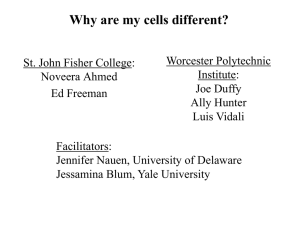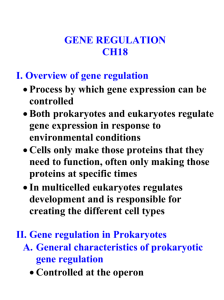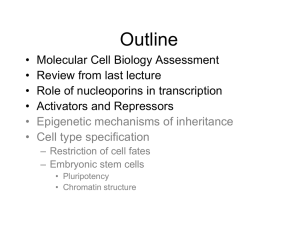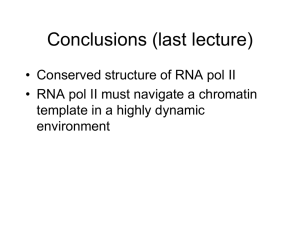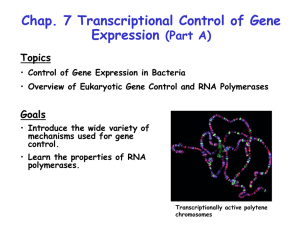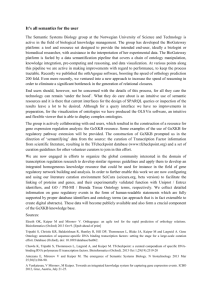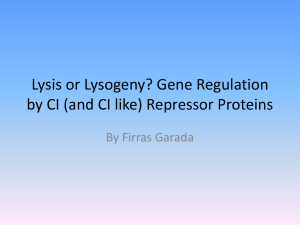REGULATION OF GENE EXPRESSION IN EUKARYOTES
advertisement
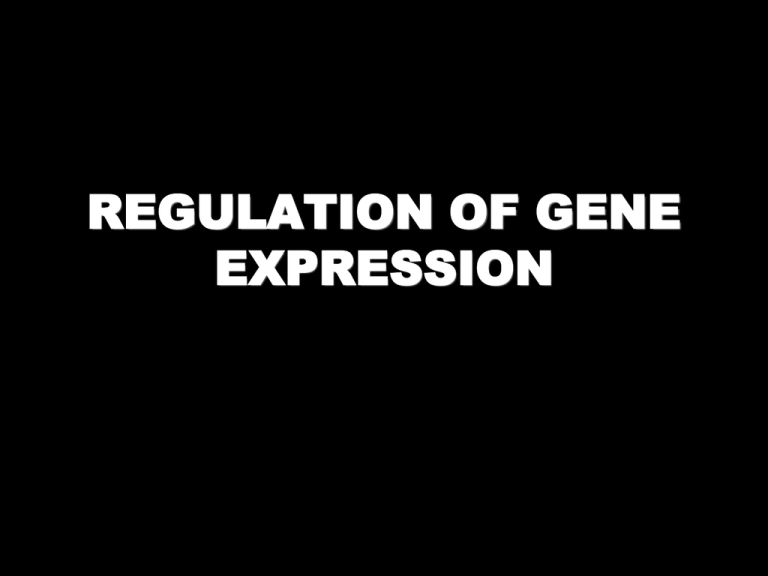
REGULATION OF GENE EXPRESSION WHY REGULATE GENE EXPRESSION?? Adaptation (Energy Conservation) Development and differentiation GENE EXPRESSION IN DIFFERENT CELLS Genes for Muscle cell Pancreatic cells alpha cells beta cells Blood cells WBCs RBCs Glycolysis ON ON ON ON ON Insulin OFF OFF ON OFF OFF Glucagon OFF ON OFF OFF OFF Hemoglobin OFF OFF OFF OFF ON A PROKARYOTIC AND EUKARYOTIC CELL REGULATION OF GENE EXPRESSION PROKARYOTES THE OPERON Operon DNA Structural Genes 5’ Promoter Polycistronic mRNA Gene 2 Gene 1 AUG UAA AUG Protein 1 Gene 3 UGA AUG Protein 2 3’ UAG Protein 3 REPRESSORS Regulatory gene mRNA Repressor RNA polymerase Operator 5’ Promoter Gene 1 Gene 2 Gene 3 3’ No transcription No protein products REGULATORY MECHANISMS INDUCTION Repressor is INACTIVATED through inducers to INITIATE / INDUCE transcription REPRESSION Repressor is ACTIVATED through corepressors to PREVENT / REPRESS transcription INDUCTION Active repressor No transcription, translation Inducer Transcription Translation Inactive repressor REPRESSION Inactive repressor Transcription Translation Corepressors Active repressor No transcription, translation GENE REGULATION IN EUKARYOTES Gene Regulation Can Take Place at Many Levels Chromosome Transcription Processing of transcripts Translation GENE REGULATION AT THE CHROMOSOMAL LEVEL Two Types of Chromatin • HETEROCHROMATIN Trancriptionally inactive tightly condensed • EUCHROMATIN Transcriptionally active Relatively relaxed CHROMATIN STRUCTURE EFFECT OF CHROMATIN STRUCTURE ON TRANSCRIPTION Control region outside within nucleosome nucleosome GENE GENEISISINACTIVE ACTIVE Histone Acetylation HAT Histone Acetylation DNA Methylation X-Inactivation • Inactive X-Chromosome (Barr body) – Underacetylated at H4 – Hypermethylated X-inactivation in humans • Red-green color blindness – Males = fully color blind – Females = mosaic retinas • Anhidrotic ectodermal dysplasia – Males = absence of teeth, lack of sweat glands – Females = random patterns of tissue with or without sweat glands Arrangement of DNA Antibody Diversity • Light chains: – Up to 300 Variable, 4 Joining and 1 Constant region • 300 x 4 = 1, 200 light chains • Heavy chains: – Up to 500 Variable, 4 Joining and 12 Diversity regions and 12 constant regions • 500 x 4 x 12 = 24, 000 light chains 1200 x 24,000 = 28,800,000 antibody molecules REGULATION AT THE LEVEL OF TRANSCRIPTION • GTFs only produce a basal level of transcription i.e. very low • Gene-specific factors (activators) are further required to regulate the activity of gene expression Enhancers/Silencers • Upstream or downstream • Close to the promoter or thousands of base pairs away • On either of the two strands of DNA • Act through intermediary or gene specific transcription factors proteins • Enhancers activate transcription • Silencers deactivate transcription Enhancers/Silencers Response Elements • Enhancers contain response elements that are responsive to certain metabolic factors –Cyclic AMP response element (CRE) –Glucocorticoid response element (GRE) –Heat shock element (HSE) • REs bind transcription factors produced under certain cell conditions to activate several related genes cAMP Response Element (CRE) 5’- TGACGTCA -3’ 3’- ACTGCAGT -5’ CREB – the most important protein that you have never heard of • Implicated in – Cell proliferation – Cell differentiation – Spermatogenesis – Release of somatostatin (inhibitor growth hormone) – Development of T lymphocytes – Metabolism of the pineal gland – Adaptation to physical stress – Transcription of metabolic enzymes – Critical in learning and long term memory Activation of CREB Glucocorticoid Response Element GENE REGULATION BY PROCESSING OF TRANSCRIPTS Alternative Splicing RNA EDITING Regulation of Translation by Phosphorylation mRNA Stability Regulation of Transferrin Expression Regulation of ferritin expression RNA Interference …will be done with therapeutics The End!


